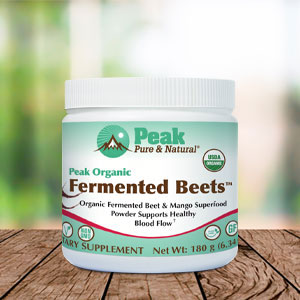Get Easy Health Digest™ in your inbox and don’t miss a thing when you subscribe today. Plus, get the free bonus report, Mother Nature’s Tips, Tricks and Remedies for Cholesterol, Blood Pressure & Blood Sugar as my way of saying welcome to the community!
Not eating your greens? A greens powder could help

According to the Centers for Disease Control and Prevention (CDC), not even ten percent of Americans eat enough vegetables for their health.
That’s not surprising if you look at the state of our health as a nation. In a study by the CDC that calculated the nutrient density for almost 50 fruits and vegetables, 17 of the top 20 were leafy greens.
But plenty of us either don’t like the taste, find them expensive (especially if trying to eat cleaner by choosing organic varieties) and don’t like that they may cause some gas and bloating. Many of us also don’t know which are the healthier choices and may be too busy to investigate and put in the time to keep our crisper drawers full of the fresh stuff.
Whatever, the reason, if you’re someone who has trouble getting enough healthy green vegetables into your diet, supplementing with a greens powder could help you make up for some of the nutrients you’re missing out.
But not all greens powders are created equal. Before you commit to one, there are some things you need to know.
What is a greens powder?
Much like protein powders, greens powders are powdered veggies that you mix with water, milk or juice to help make up for a lack of vegetables in your diet. Or, for some people, choosing a greens powder may be purely about convenience.
A greens powder is no substitute for eating well, but it will give you important minerals like calcium and potassium, as well as more hard-to-get minerals like selenium, chromium and iodine.
And greens powders are good vitamin sources. For example, on average, a tablespoon of greens powder gives you 60 percent of your RDA (recommended daily allowance) of Vitamin A.
5 health benefits of green nutrition
Some of the healthiest and most nutrient-dense leafy greens are kale, watercress, spinach, collard greens, chard, leaf lettuce, and arugula. They can have a big impact on your health.
Blood pressure. Minerals like calcium and potassium are crucial for maintaining healthy blood pressure. Studies have found that a daily serving of greens can result in a decrease in both systolic and diastolic blood pressure.
Immune system. The vitamin A found in green leafy vegetables has anti-inflammatory properties that support the immune system. Selenium, too, is proven to help the immune system fight infection.
Balances your body’s pH.. The typical American diet of meat and processed foods puts us in an acidic state. Green vegetables, especially raw, can help shift your body’s pH balance toward a more alkaline state.
Free-radical damage. One study found that a daily serving of greens powder reduced oxidative damage by thirty percent.
Eye and cognitive health. Recent studies have found that Vitamin K found in leafy greens may also promote healthy eyes and support cognition. Greens are also great sources of lutein and zeaxanthin.
5 supergreen ingredients packed with nutrition
In spite of all the options for delicious leafy greens, if you feel you don’t get enough in your diet, a greens powder could help.
As we mentioned earlier, not all greens powders are created equal. You want to select one with the most nutritious combination of ingredients possible. That should include some leafy greens like kale, spinach and hopefully some cruciferous vegetables like broccoli.
Supergreens are a popular addition to greens powders too and may include:
Wheatgrass. Wheatgrass juice or powder is prepared from the young shoots of the common wheat plant. It is especially high in vitamins A, C and E, as well as iron, magnesium, calcium and amino acids.
The chlorophyll in wheatgrass helps detoxify the liver and speeds up the elimination of toxins from the body.
Spirulina. Spirulina is a type of microscopic algae that was eaten by the ancient Aztecs. Spirulina is 48 percent protein and a good source of choline.
Spirulina has powerful anti-inflammatory properties and may help lower LDL (“bad”) cholesterol. It is thought to reduce blood pressure and aid in blood sugar control.
Spirulina is an excellent plant source of omega-3s, beating out nuts and seeds which only contain ALA and not EPA and DHA — the fatty acids linked primarily to researched benefits, like promoting brain health and decreasing inflammation.
Dulse. Dulse is a type of seaweed, so it’s rich in iodine which supports the thyroid. Dulse is a great source of B-vitamins and protein.
Chlorella. Chlorella is another algae with similar nutritional content and similar benefits to spirulina. There are some differences, though. For example, chlorella has more omega-3 fatty acids than spirulina. It’s also a good source of protein and folate.
According to WebMD.com, we’re exposed to toxins like heavy metals through diet, lifestyle, and environmental factors such as pollution. High levels can lead to organ damage. Chlorella can bind to these heavy metals, flushing them from your system before being absorbed by your body.
Beets. Beet powder is high in nitrates, a naturally occurring substance that helps the body produce nitric oxide to support vascular function and encourage healthy blood flow.
One downside to greens powders you don’t have to worry about when eating real greens is the loss of fiber. During processing, the fiber is lost (if you’re a fan of juicing your fruits and veggies you’ll experience the same loss of fiber content). Some greens powders may add in fiber, so be sure to look for that.
The importance of organic ingredients
Greens powders can come with the same possibility of contamination as whole fruits and vegetables when not choosing organic ingredients.
Just like eating vegetables grown with pesticides, herbicides and hormones, using a greens powder made from vegetables grown in this way puts these toxins into your body.
And why take the trouble to supplement with this great superfood, if you’re counteracting its benefits by introducing toxins into your body every time you drink it?
A well-rounded whole foods diet, plentiful in green leafy vegetables is always best and you should strive to include more in your diet regularly. Consider trying out one new leafy green food on a weekly basis and ease it into your meals, experimenting with different ways to enjoy it, cooked or raw. But if you find your diet lacking for whatever reason, it’s good to know you have options.
Editor’s note: Have you heard of EDTA chelation therapy? It was developed originally to remove lead and other contaminants, including heavy metals, from the body. Its uses now run the gamut from varicose veins to circulation. Click here to discover Chelation: Natural Miracle for Protecting Your Heart and Enhancing Your Health!
Sources:
The Health Benefits of Leafy Greens — Consumer Reports
Eat your greens — WebMD
Vitamin K2 status linked to brain and eye health — NattoPharma
Greens Powder: Are there Health Benefits? — Nourish (WebMD)
9 Surprising Benefits of Dulse — Organic Facts
7 Evidence-Based Benefits of Wheatgrass — Healthline
9 Surprising Benefits of Dulse — organicfacts.net














